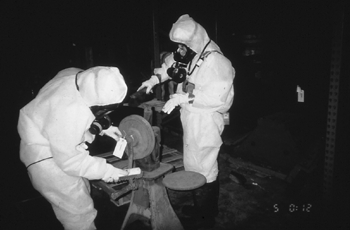ACCESS DENIED: ASBESTOS CONTAMINATION AS CATALYST AND HINDRANCE TO COLLECTION RETRIEVAL AND PRESERVATIONVIRGINIA M. DEUCHER, TAMURA L. MOORE, & STEVE HEMLIN
5 5. DECONTAMINATION METHODS AND CLEARANCE PROTOCOLSThe planning team estimated that more than 95% of the objects could be decontaminated and removed from the building. One basic premise governed the decontamination methods: all objects would be decontaminated for “normal museum use,” which meant the objects could be handled, examined, moved, cleaned, exhibited, rehoused, or photographed without requiring personal protective equipment. One cautionary note: normal museum use did not include disassembly of objects. The planning team's goal in developing the decontamination protocols was to determine a balance between staff safety (keeping ambient air fiber counts low) and effective decontamination methods based on object material types and surface fragility. Objects or surface types were divided into categories such as metals, sealed woods (painted or varnished), unsealed woods, glass, textiles, paper, plastics, rubber, fiberglass, and hazardous collections. These categories were then matched to an appropriate decontamination method that would do the least harm to the object, yet sufficiently remove the asbestos. Throughout the planning phase, the asbestos-removal contract consultants indicated that, from their experience, the most effective and efficient method for decontaminating items was the use of water amended with surfactant (liquid soap) to bind the asbestos fibers for easier removal (fig. 2). However, the planning team recognized that not all objects could withstand this wet method, and so other decontamination methods were developed. These included, from the most to least intrusive:
After an object had been decontaminated through the application of a single or in some cases a combination of cleaning methods, the object was ready for clearance testing, a procedure performed prior to releasing the objects from the asbestos containment. The purpose of clearance testing was to ensure that the asbestos fibers had been successfully removed to within the decontamination clearance levels established for this project. Clearance testing fell into two primary categories—visual or aggressive air sampling. The visual procedure was valid only for objects with flat surfaces and consisted of a visual review of surfaces free of holes and crevices or gaps for signs of residual asbestos insulation, as well as a hand-wipe over the artifact to look for cleanliness. If there was no evidence of residual insulation, dirt, or other surface debris, the object passed. The air-testing procedures included the use of an air-sampling pump with tubing, a cassette with cellulose filter, a leaf blower, and fans. Air in the test chamber was disturbed by a leaf blower, after which fans were left on in the chamber in order to keep fibers (if any) aloft during the testing. The sampling pump drew air through the filter into a cassette at a minimum of 1,200 l of air over approximately 2 hours. This procedure is directly analogous to the “aggressive” air sampling method typically conducted in a building for the purpose of cleaning the area for reoccupancy after an asbestos abatement project. The sampling analysis consisted of either phase contrast microscopy (PCM) or transmission electron microscopy (TEM). PCM analysis costs approximately $20 per test. Slides were prepared and read on-site, with results available in about 20 minutes. PCM analysis does not differentiate between types of fibers, such as dust, paper, wood, or clothing; every type of fiber is counted in the results of the test and therefore would not provide valid results for items that were inherently fibrous, such as textiles and paper. For these materials, TEM analysis was used. To perform a TEM analysis, the cassette filters were sent to a laboratory, where all nonasbestos fibers were burned off, leaving only the asbestos fibers intact. TEM analysis also identifies the specific asbestos fiber present, such as amosite or crysotile. TEM analysis costs from $100 (for results available in 72 hours) to $200 (for results in 24 hours). During TEM testing, the test chamber was unavailable for an extended period, resulting in a slowdown of the entire project. |
